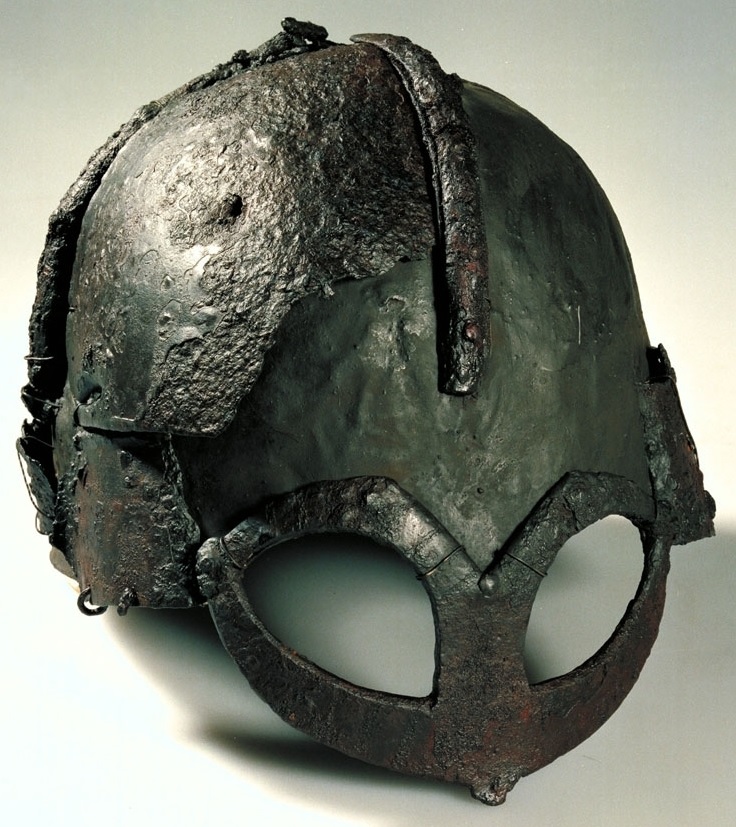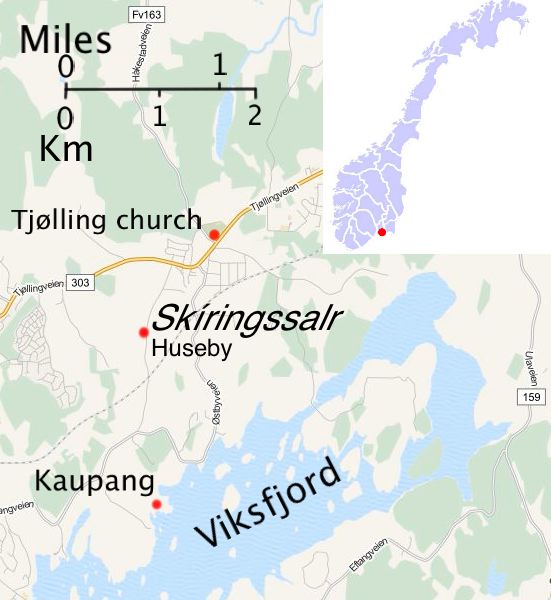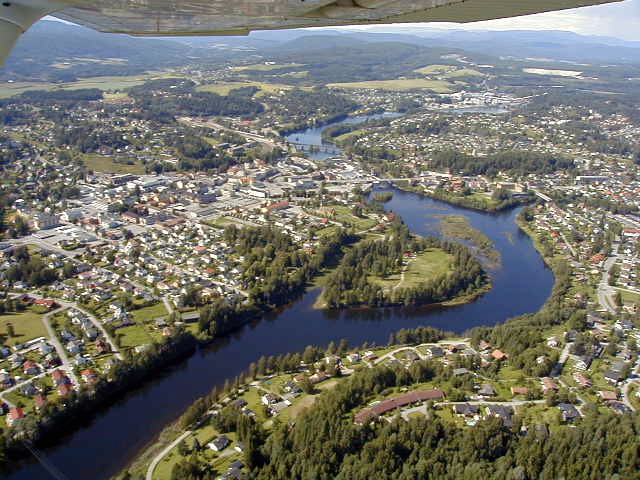|
Gjermundbu Helmet
The Gjermundbu helmet is a Viking Age helmet. The helmet was discovered during field clearing in 1943 at the Gjermundbu farm near Haugsbygd in the municipality of Ringerike in Buskerud, Norway. Officials at the University of Oslo were later notified. Conservator Sverre Marstrander and museum assistant Charlotte Blindheim led an investigation which confirmed the existence of a burial chamber of historic value dating from the Viking era. The Gjermundbu finds (''Gjermundbu-funnet'') contained many artifacts including articles of weaponry. The Gjermundbu helmet was found in nine fragments and was subsequently restored. The helmet was made of iron and was in the shape of a peaked cap made from four plates. It is now on display at the Museum of Cultural History of the University of Oslo. Together with the Tjele helmet fragment, two fragments from Gotland, and one fragment from Kyiv, it is the only known Viking helmet capable of reconstruction. See also *Yarm helmet The Y ... [...More Info...] [...Related Items...] OR: [Wikipedia] [Google] [Baidu] |
Viking Era
The Viking Age () was the period during the Middle Ages when Norsemen known as Vikings undertook large-scale raiding, colonizing, conquest, and trading throughout Europe and reached North America. It followed the Migration Period and the Germanic Iron Age. The Viking Age applies not only to their homeland of Scandinavia but also to any place significantly settled by Scandinavians during the period. The Scandinavians of the Viking Age are often referred to as ''Vikings'' as well as ''Norsemen'', although few of them were Vikings in sense of being engaged in piracy. Voyaging by sea from their homelands in Denmark, Norway, and Sweden, the Norse people settled in the British Isles, Ireland, the Faroe Islands, Iceland, Greenland, Normandy, and the Baltic coast and along the Dnieper and Volga trade routes in eastern Europe, where they were also known as Varangians. They also briefly settled in Newfoundland, becoming the first Europeans to reach North America. The Norse ... [...More Info...] [...Related Items...] OR: [Wikipedia] [Google] [Baidu] |
Germanic Archaeological Artifacts
Germanic may refer to: * Germanic peoples, an ethno-linguistic group identified by their use of the Germanic languages ** List of ancient Germanic peoples and tribes * Germanic languages :* Proto-Germanic language, a reconstructed proto-language of all the Germanic languages * Germanic name * Germanic mythology, myths associated with Germanic paganism * Germanic religion (other) * SS ''Germanic'' (1874), a White Star Line steamship See also * Germania (other) * Germanus (other) * German (other) * Germanicia Caesarea Marash (Armenian: Մարաշ), officially Kahramanmaraş () and historically Germanicea (Greek: Γερμανίκεια), is a city in the Mediterranean Region of Turkey and the administrative center of Kahramanmaraş Province. Before 1973, Kahra ... * * {{disambiguation Language and nationality disambiguation pages ... [...More Info...] [...Related Items...] OR: [Wikipedia] [Google] [Baidu] |
1943 Archaeological Discoveries
Events Below, the events of World War II have the "WWII" prefix. January * January 1 – WWII: The Soviet Union announces that 22 German divisions have been encircled at Stalingrad, with 175,000 killed and 137,650 captured. * January 4 – WWII: Greek-Polish athlete and saboteur Jerzy Iwanow-Szajnowicz is executed by the Germans at Kaisariani. * January 11 ** The United States and United Kingdom revise previously unequal treaty relationships with the Republic of China (1912–1949), Republic of China. ** Italian-American anarchist Carlo Tresca is assassinated in New York City. * January 13 – Anti-Nazi protests in Sofia result in 200 arrests and 36 executions. * January 14 – January 24, 24 – WWII: Casablanca Conference: Franklin D. Roosevelt, President of the United States; Winston Churchill, Prime Minister of the United Kingdom; and Generals Charles de Gaulle and Henri Giraud of the Free French forces meet secretly at the Anfa Hotel in Casablanca, Morocco, to plan the ... [...More Info...] [...Related Items...] OR: [Wikipedia] [Google] [Baidu] |
Yarm Helmet
The Yarm helmet is a ca 10th-century Viking age helmet that was found in Yarm in the North Riding of Yorkshire, England. It is the first relatively complete Anglo-Scandinavian helmet found in Britain and only the second relatively complete/intact Viking helmet discovered in north-west Europe. The helmet was discovered in the 1950s by workmen digging pipe trenches in Chapel Yard, Yarm, near the River Tees. Research led by Chris Caple of Durham University, and published in 2020, established that the helmet dates to the 10th century. It is on display at the Preston Park Museum in Stockton-on-Tees. It is on loan from Yarm Town Council. The iron helmet is made of bands and plates, riveted together, with a simple knop at the top. Below the brow band it has a "spectacle" guard around the eyes and nose forming a sort of mask, which suggests an affinity with earlier Vendel Period helmets. The lower edge of the brow band is pierced with circular holes, where a mail curtain (or aventail ... [...More Info...] [...Related Items...] OR: [Wikipedia] [Google] [Baidu] |
Kiev
Kyiv, also spelled Kiev, is the capital and most populous city of Ukraine. It is in north-central Ukraine along the Dnieper River. As of 1 January 2021, its population was 2,962,180, making Kyiv the seventh-most populous city in Europe. Kyiv is an important industrial, scientific, educational, and cultural center in Eastern Europe. It is home to many high-tech industries, higher education institutions, and historical landmarks. The city has an extensive system of public transport and infrastructure, including the Kyiv Metro. The city's name is said to derive from the name of Kyi, one of its four legendary founders. During its history, Kyiv, one of the oldest cities in Eastern Europe, passed through several stages of prominence and obscurity. The city probably existed as a commercial center as early as the 5th century. A Slavic settlement on the great trade route between Scandinavia and Constantinople, Kyiv was a tributary of the Khazars, until its capture by the Vara ... [...More Info...] [...Related Items...] OR: [Wikipedia] [Google] [Baidu] |
Gotland
Gotland (, ; ''Gutland'' in Gutnish), also historically spelled Gottland or Gothland (), is Sweden's largest island. It is also a province, county, municipality, and diocese. The province includes the islands of Fårö and Gotska Sandön to the north, as well as the Karlsö Islands (Lilla and Stora) to the west. The population is 61,001, of which about 23,600 live in Visby, the main town. Outside Visby, there are minor settlements and a mainly rural population. The island of Gotland and the other areas of the province of Gotland make up less than one percent of Sweden's total land area. The county formed by the archipelago is the second smallest by area and is the least populated in Sweden. In spite of the small size due to its narrow width, the driving distance between the furthermost points of the populated islands is about . Gotland is a fully integrated part of Sweden with no particular autonomy, unlike several other offshore island groups in Europe. Historically there w ... [...More Info...] [...Related Items...] OR: [Wikipedia] [Google] [Baidu] |
Tjele Helmet Fragment
The Tjele helmet fragment is a Viking Age fragment of iron and bronze, originally comprising the eyebrows and noseguard of a helmet. It was discovered in 1850 with a large assortment of smith's tools in Denmark, and though the find was sent to the National Museum of Denmark, for 134 years the fragment was mistaken for a saddle mount. In 1984 it was properly identified by an assistant keeper at the museum as the remainder of one of only five known helmets from the Viking era. Dating to approximately 950 to 970 AD, the Tjele fragment is joined by the Gjermundbu helmet, two fragments from Gotland, and one from Kiev, as the known Viking Age helmets. These represent the final evolution of the "crested helmets" used in Europe from the sixth century onwards, and known primarily for Anglo-Saxon and Vendel Period examples such as the Sutton Hoo helmet. The Tjele fragment is one of only two such helmets discovered in Denmark; the earlier Gevninge helmet fragment, made in approximately 5 ... [...More Info...] [...Related Items...] OR: [Wikipedia] [Google] [Baidu] |
Museum Of Cultural History, Oslo
Museum of Cultural History ( no, Kulturhistorisk museum, KHM) is an association of museums subject to the University of Oslo, Norway. KHM was established in 1999 as ''Universitetets kulturhistoriske museum'' with the merging of the bodies ''Universitetets Oldsaksamling'' which housed a collection of ancient and medieval objects, Viking Ship Museum (''Vikingskipshuset'') at Bygdøy, the Coin Cabinet (''Myntkabinettet'') and Ethnographic Museum (''Etnografisk samling''). In 2004 the name was changed to ''Kulturhistorisk museum''. The activities of the Museum of Cultural History are currently localized in four main buildings in Oslo city centre: Historical Museum at Frederiks gate 2 and Frederiks gate 3 and administration at St. Olavs gate 29, as well as the Viking Ship Museum on the Bygdøy peninsula.Anne-Sofie Hjemdah''Historisk museum – norsk museumsbygning i Oslo'' (Store norske leksikon)/ref> The Museum of Cultural History is one of Norway's largest cultural history muse ... [...More Info...] [...Related Items...] OR: [Wikipedia] [Google] [Baidu] |
Charlotte Blindheim
Charlotte Blindheim (née Undset, 6 July 1917 – 5 March 2005) was a Norwegian archaeologist. She was the first female member of the scientific staff at the University of Oslo to be permanently employed when she hired as the museum curator in 1946. Biography She was born in Kristiania (now Oslo), Norway. She was the daughter of Sigge Pantzerhielm Thomas (1886-1944) and Signe Dorothea Undset (1887-1973). Her father was a classical philologist and lecturer at the University of Oslo. She completed a master's degree in archaeology in 1946 at the University of Oslo, writing her thesis on Viking costume and jewellery. She was subsequently hired as a curator at the University as the museum's first permanently employed female member of scientific staff. As an archaeologist, Blindheim became particularly known for her work with the excavations at Kaupang in Skiringssal in the former municipality of Tjølling (now Larvik in Vestfold). Excavations were started systematically in the s ... [...More Info...] [...Related Items...] OR: [Wikipedia] [Google] [Baidu] |
Ringerike (municipality)
Ringerike is a municipality in the traditional and electoral district Buskerud in Viken county, Norway. It is part of the traditional region of Ringerike. The administrative centre of the municipality is the town of Hønefoss. The municipality of Ringerike was created on 1 January 1964 after the merger of the town of Hønefoss and the rural municipalities of Hole, Norderhov, Tyristrand, and Ådal. However, the area of Hole was removed from the municipality of Ringerike on 1 January 1977 to become a separate municipality once again. The historic area of Ringerike included not just the modern municipality of Ringerike but also Hole and Krødsherad, Modum and Sigdal. General information Etymology The Old Norse form of this name was ''Hringaríki''. The first element is (probably) the genitive plural of ''hringir'', the name of an old Germanic tribe. The last element is ''ríki'' n 'kingdom, reich'. (See also Romerike.) Coat of arms The coat of arms were granted on 16 J ... [...More Info...] [...Related Items...] OR: [Wikipedia] [Google] [Baidu] |
Sverre Marstrander
Sverre Marstrander (24 October 1910 – 20 September 1986) was a Norwegian professor in archaeology. Marstrander was born in Oslo, Norway. He earned his Magister degree in classical archaeology at the University of Oslo in 1937. He worked with the Royal Norwegian Society of Sciences and Letters at Trondheim (1948–1968). Marstrander became a professor in Nordic archaeology at the University of Oslo in 1968. In that same year he was appointed as the manager of the University of Oslo Museum of National Antiquities (''Oldsaksamlingen'') and was in the position until 1980. His most important studies were in the research of Norwegian Bronze Age rock carvings, which showed in his dr.philos. A Doctor of Philosophy (PhD, Ph.D., or DPhil; Latin: or ') is the most common degree at the highest academic level awarded following a course of study. PhDs are awarded for programs across the whole breadth of academic fields. Because it is a ... dissertation from 1963; ''Østfolds jordbruksr ... [...More Info...] [...Related Items...] OR: [Wikipedia] [Google] [Baidu] |



.jpg)





